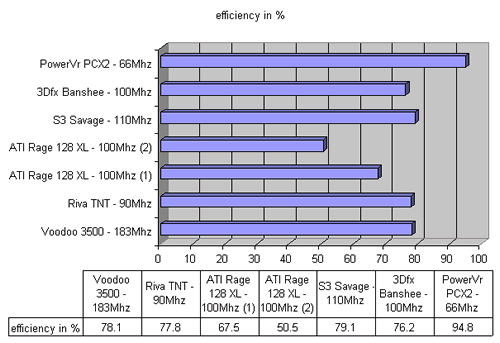Fill-Rate Efficiency
To get a good idea about the difference between Theory and Reality I will introduce fill-rate Efficiency. Basically its just a percentage number that shows the difference. Calculation is simple you divide the Real World fill-rate by the Theoretical Peak fill-rate and the result of that is multiplied with 100. Results is a percentage:

These numbers show that no accelerator achieves 100% efficiency. Most accelerators are running at about 80% of their theoretically claimed numbers. There are 2 exceptions to this rule : PowerVR PCX2 and the ATI Rage128 GL.
VideoLogic's PowerVR chip has an efficiency of almost 95%. This is very good and its mainly due to the non-traditional way of rendering used by the chip. The PowerVR architecture doesn't use a Z-Buffer in external memory and this results in no penalties for Buffer Clears. Due to intelligent rendering and caching the number of Page Breaks is also reduced.
ATI's latest chip scores very poorly on the fill-rate Efficiency test. Even more the fill-rate seems to depend on the resolution used. The efficiency at 1600x1200 is about 17% higher than the efficiency at 640x480. This difference is probably due to higher efficiency of the pixel cache of the ATI chip (the output is buffered and this becomes more efficient at higher resolutions). Still this doesn't explain the low numbers since the highest efficiency of the ATI chip is still 10% below the average score of the competition. Exactly why this is the case is a bit of a mystery at the moment. If you know why the ATI chip scores so poorly then drop me a line at this email address.
